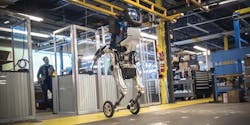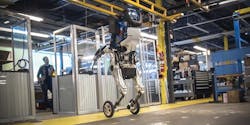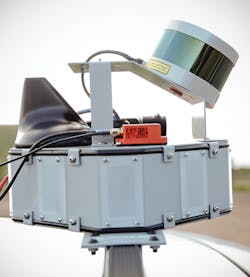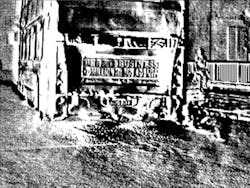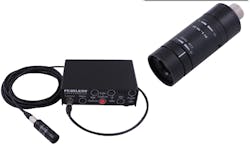May 2017 snapshots: Boston Dynamics robot, autonomous vehicles, infrared imaging
"Handle" wheeled robot officially unveiled by Boston Dynamics
In early February, we reported that "Handle," a new robot that features both legs and wheels, was shown in a video at a presentation for investors. At this time, only a video recorded on someone's smartphone recording the footage of Handle was available. Less than a month later, Boston Dynamics (Waltham, MA, USA; www.bostondynamics.com) has released a high-resolution video of the wheeled robot in action.
The founder of Boston Dynamics - a subsidiary of Google's parent company Alphabet (Mountain View, CA, USA; www.abc.xyz) - commented on the robot at the January 31 presentation.
"Everybody thinks we only do legged robots, so no one has seen this, you are the first," he told the crowd. "This is the debut presentation of what I think will be a nightmare-inducing robot, if you're anything like me."
Raibert explained that the robot is an experiment with combining wheels with legs with a dynamic system that is constantly balancing itself. In the video, the robot can be seen spinning around rapidly, darting across a room, rolling down a small grassy hill, and even jumping over an object.
Boston Dynamics called the robot "Handle" as its designed to handle objects. In the video, the robot can be seen picking up a milk crate, and it indicates that the robot can carry up to 100 lbs. Handle is 6.5 ft. tall, can jump 4 ft., travels at speeds of up to 9 mph, and has a range of about 15 miles on one battery charge and uses many of the same dynamics, balance, and mobile manipulation principles found in Boston Dynamics' other robots, but with only about 10 actuated joints, it is much less complex.
Development kit from Civil Maps enables 3D mapping for autonomous vehicles
Civil Maps (Albany, CA, USA; www.civilmaps.com) a company specializing in 3D mapping for autonomous vehicles, has announced the release of the Atlas DevKit platform, a hardware and software offering that enables the creation and conversion of sensor data into 3D semantic map data.
The reference kit, a car-mounted hardware unit and its companion software suite, are designed for self-driving car developers and others seeking to build and utilize machine-readable maps that can be crowd sourced. The hardware is made up of third-party sensors that include LIDAR, cameras, measurement systems, and communication devices in a self-contained, plug-and-play package.
Civil Maps is a business that the Ford Motor Company (Dearborn, MI, USA; www.ford.com) has invested in for its ability to develop high-resolution 3D maps of autonomous vehicle environments.
"Advanced localization, map creation, and crowdsourcing of maps are key challenges facing those hoping to test and deploy autonomous vehicle technology," said Sravan Puttagunta, Co-founder and CEO of Civil Maps. "The Atlas DevKit platform accelerates the pace of innovation by enabling developers to quickly and economically localize vehicles, build dynamic maps, and crowdsource that critical information with other cars in real-time."
The Atlas DevKit platform will start at $20,000 as part of a research and development (R&D) contract with the company. Since Fall 2017, automotive R&D teams have used the kit in three continents.
"Installation and usage is easy," noted Civil Maps in its press release. "Developers simply mount the kit to a car's roof rack and use it with Civil Maps' machine learning software. Rather than utilizing expensive, custom-built solutions that can take months to deploy, R&D teams are able to start mapping immediately."
The platform runs on a single board ARM processor and features advanced localization in 6 dimensions (x, y, z, roll, pitch, yaw) within 10 cm accuracy. It features a low data footprint of +/- 120 kb per km, multi-sensor compatibility, and 4G for remote provisioning and real-time map building. An alternative version of the platform, the Atlas Lite DevKit, integrates with a vehicle's existing sensors.
The Atlas DevKit was recently recognized as an Innovation Honoree in the Vehicle Intelligence category of the 2017 CES Innovation Awards. Those interested in the platform are encouraged to contact [email protected]. View a YouTube video of the Atlas DevKit system in action at http://bit.ly/VSD-Atlas.
Infrared camera shows the impact of vehicle emissions
In an effort to visually demonstrate the potentially fatal impacts of air pollution, FLIR Systems (Wilsonville, OR, USA; www.flir.com) has released a new video containing footage captured by FLIR infrared cameras that shows vehicle emissions and the resulting pollution issues.
A recent World Health Organization statistic shows that air pollution kills 16,000 British people a year, and the UK's largest source of air pollution is transportation, according to Martin Williams, Professor of Air Quality at Kings College London (London, UK; www.kcl.ac.uk).
"I'm not sure the message is getting across as well as it could, and it's a very significant public health burden," he said. "I'm sure the public at large don't really appreciate the size of the burden."
"Raising awareness," he continued, "would be vastly improved by modern technology that display things rather than rely on words."
To accomplish this, FLIR used its GF320 infrared camera to capture video of the emissions. This camera features a 320 x 240 cooled InSb infrared detector with a spectral response of 3.2 to 3.4 μm. Designed specifically for gas leak detection and electrical inspection, the camera also embeds GPS data into the image, allowing workers to pinpoint the location of the leak or hot spot.
By using infrared technology, you can physically see pollutants and how they spread from the source, into the air. Optical Gas Imaging (OGI) cameras based on infrared technology, that physically show pollution – whether fumes from a car, airplane or train – will help enormously in getting the message across," said Williams. One major concern of Williams' is the idea of children being so close to the pollution. "If parents could see what it looks like pushing their child through a band of raw pollution, they would take preventive action."
FLIR's Chris Brown notes that this work only scratches the surfaces when it comes to raising awareness about the harmful effects of air pollution and reducing its impact.
He added "Infrared technology, or thermal imaging, is really important in the context of air pollution as unfortunately, we are only born with five senses. In effect, infrared technology provides us with a sixth sense – allowing us to see air pollution before and while it's happening."
View the video here: http://bit.ly/VSDSnap1705
Industrial camera targets retrofits for popular discontinued models
Both the ELMO (Plainville, NY, USA; www.elmousa.com) MN43H camera and the Toshiba (Irvine, CA, USA; www.toshibacameras.com) IK-M44H equivalent were popular camera models around which many imaging systems were designed around due to their size. With the cameras now being discontinued, however, many customers have systems that require this particular camera size and the camera's adjustable iris.
This camera, according to Chris Lynch of Peerless Creations (Ledgewood, NJ, USA; www.peerlesscreations.com), was so popular because it was one of the first lipstick-sized cameras, and featured 768x494, 1/3-inch 410,000 pixel CCD, with micro lens technology and 17mm in diameter.
"The way the market has changed, with so many people going toward security because of high volume, both companies stopped making the camera."
After a customer of Peerless Creations reached out to the company to see if they could develop a product that could be dropped into their machine, a new alternative to the aforementioned cameras is now available. The PC-HD17 camera from Peerless Creations is a full HD 1080p lipstick-sized camera with on-board recording and a housing that directly mimics the discontinued cameras. The camera features a 17 mm diameter, HDMI interface, composite video DVR kit, and the same type of filters that thread onto the camera and feature an adjustable iris, which is necessary for customers in the welding market, according to Lynch.
Furthermore, the camera features the 1/3" 3 MPixel AR0330 CMOS image sensor from ON Semiconductor (Phoenix, AZ, USA; www.onsemi.com), which features a 2.2 μm pixel size and can reach a frame rate of 60 fps.
"People have these systems that have been invested in, and have all these cameras that don't fit," said Lynch. "Customers have tried to replace with other cameras, and have had no success. This is why we developed the PC-HD17."
View more here: http://bit.ly/VSD-Peer.
